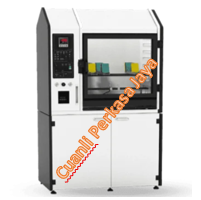Environmental Gauge
The environmental gauge used to measure the conditions during pre-treatment and application of a coating system. They are the major factors affecting the long-term performance of coatings on steel structures. Environmental Gauge can be used to monitor environmental conditions before, during and after painting. Ideal for surface preparation as required by ISO 8502-4, an electronic Dew Point Meter determines the likelihood of dew forming on structures which are being painted.
Why Environmental Gauge Important ?
Temperature, humidity and also related climatic parameters are important to many industrial processes. And the application of paint and coatings is no exception to that rule. Measuring and controlling climatic parameters such as:. Relative humidity, air-temperature, dewpoint and moisture is vital to a successful application of high-end coating systems. Incorrect climatic conditions during pre-treatment and application often lead to premature failing of coatings systems.
Temperature and relative humidity during application
Most two component epoxies require a relatively high temperature (often more than 15°C) combined with a low relative humidity. Moisture curing coatings need a high humidity level in order to cure. Water based coatings cannot be applied at very low temperatures and too low humidity. It will causes the paint to dry too fast while a high humidity slows the curing process down. Surface tolerant coatings accept a wider range of climatic conditions and some coatings can even be applied underwater.
When is it safe to paint?
The difference between the surface temperature and the dew point temperature is the most critical, determining factor for the long-term performance of coatings and linings on steel structures.
Documents such as ASTM D3276 and the international standard ISO 8502-4 state that the surface temperature must be a minimum of 5°F (3°C) above the dew-point temperature during the critical 3 phases of coating: preparation, application and cure. This minimum separation also helps allow for surface temperature reduction as solvents evaporate or when cold coating materials are applied.
If the dew point temperature is below this minimum separation, or even if they are close, the risk on moisture forming on the steel surface may be unacceptably high and may lead to coating failure.
Why is it important to measure dew point in compressed air?
When air is compressed, the gasses (oxygen, nitrogen, etc.) become more dense. As a result, the liquid water vapor within that air can easily reach saturation, especially in warmer environments such as factories.
Some industries monitor compressed air systems for moisture and dewpoint temperatures. Since moisture can have a negative effect on the adhesion, color, and gloss of spray-applied coatings using compressed air. Wet compressed air can cause damage to components allowing rust and corrosion to build up. Most problems can be avoided by simply monitoring dew point temperatures in compressed air systems.
MOISTURE
The term “Moisture is often confused with “humidity”. Humidity or better relative humidity is defined as the ratio of the partial pressure of water vapor in the mixture to the saturated vapor pressure of water at a prescribed temperature.” Products to define humidity and other climatic parameters are presented in our section Climatic Conditions.
Our environmental gauge products as follow:
Showing all 8 results









